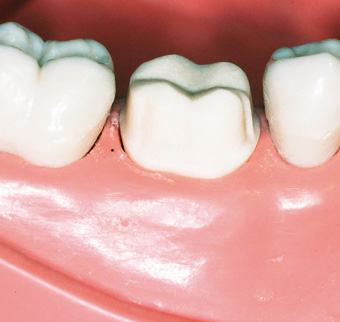Managing the biting forces
Prosthodontic specialist Dr Paul A. Tipton continues his series of articles on the basic principles of tooth preparation techniques by looking at posterior crowns
In this article we will discuss the topic of posterior porcelain-bonded-to-metal crowns. The routine use of porcelain occlusal surfaces is not without its critics but it offers maximum cosmetic effect when indicated for a highly visible area or because of patient preference.
Many dentists are currently being seduced by labs and manufacturers to use ‘reinforced’ all ceramic crowns either cemented or bonded for molar teeth. The readers should realise that there are no current studies which give a 90 per cent plus success rate for these crowns over a period of five years.
The biting forces posteriorly are far greater than anterior forces and at present appear too great for the routine use of all ceramic posterior crowns.
While the coping appear strong enough, in most cases the repeated failures have been due to the nature of the ceramic veneering materials.
Preparation
Shillinburg states that the maxillary premolars, occlusal first molar and the mandibular first premolars are almost always in the appearance zone. Mandibular molars may also have to be included if the patient is bothered by the presence of metal on those teeth.
However, it requires the removal of greater quantities of tooth structure (õ.5mm) which can pose a real threat to the structural integrity of the opposing occlusal surfaces. Although wear should not occur if attention is paid to the occlusion when the restorations are fabricated and inserted, inspection of mouths restored in this manner all too frequently exhibits heavy facets opposing these types of restorations.
Often fracture of porcelain will have occurred if enough depth of preparations is not achieved, especially in the central groove.
For this reason the preparation should be an even reduction of õ.5mm with an extra 0.5mm off the functional cusp (functional cusp bevel) and the angle of the occlusal surfaces mimicking the cuspal angles of the adjacent natural teeth.
Preparations for porcelain-fixed-to-metal crowns should be done with a preparation plan in mind for the extension of porcelain coverage only to those areas readily visible in the mouth which will then require metal coverage.
Although the occlusal surface will often be seen, the lingual will mostly not and also attention needs to be paid to the embrasure areas. In these areas the margin preparation will change the shoulder or deep chamfer õ.2-õ.5mm labially to the light chamfer 0.5mm. In turn, the wings of the preparation will appear.
These wings should be prepared where the visible areas of the crown change into the non-visible areas. The net effect of this is that possibly 60-80 per cent of the axial walls are prepared for a 0.5mm reduction, as for a gold shell crown. This drastically reduces the amount of tooth preparation required as heavy preparation is only required over the occlusal surface and mesio-buccally. These axial walls in non-aesthetic areas will finish at the margin with a metal finish line.
This will vary from mouth to mouth but will normally be in the mid mesial contact area with the adjacent crown but labio distal to the distal contact area.
About the author
A highly respected specialist in prosthodontics, Paul has published many scientific articles in the dental press and is an expert lecturer in his field with Tipton Training Academies in Dublin, Manchester, Leeds and London.
After gaining his masters degree in conservative dentistry in 1989, he was awarded the diploma in general dental practice by the Royal College of Surgeons four years later and received specialist status in prosthodontics in 1999 from the GDC.
He is currently the president of the British Academy of Dental Implantology and one of the UK’s most successful dental teachers in the fields of restorative, cosmetic and implant dentistry.
Paul teaches tooth preparation techniques on his ‘Practical Phantom Head Course’, starting 17 September in Dublin, Belfast and Scotland. For details, contact Ralf Sander at TG Medical on 00353 1 452 4818. He takes referrals for advanced restorative dentistry, implant prosthodontics and cosmetic dentistry from his clinics in London, Leeds and Edinburgh (tel: + 44 (0) 845 528 0088).

